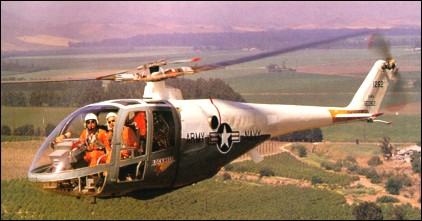
| Lockheed Model 186 / CL-575 / XH-51 1964 |  |
 |

| Lockheed Model 186 / CL-575 / XH-51 1964 |  |
 |
|
The Lockheed Model 186 was designed in response to a 1960 joint Army/Navy requirement for a high-speed, highly manoeuvrable research helicopter. Two examples were ordered in early 1962, with the first of the two making its maiden flight in November of that year. The aircraft, designated XH-51A, were operated by both Army and Navy pilots and carried Navy Bureau numbers (151262 and 151263) in addition to markings indicating their dual-service status. In keeping with its intended role of high-speed research vehicle the XH-51A was far more streamlined than most contemporary helicopters. The craft's aluminum skin was flush-riveted to the extensively flush-sealed fuselage frame, the engine air intake scoops were faired into the upper fuselage decking, the skid landing gear was retractable, and the main rotor plane was tilted a few degrees forward of the fuselage datum line. All these features combined gave the XH-51A an extremely low aerodynamic drag coefficient, which in turn resulted in a maximum level speed of 180kph. The craft's rigid main rotor, a system pioneered by Lockheed on its earlier CL-475 research helicopter, made the XH-51A extremely agile and allowed it to perform flight manoeuvres previously possible only in fixed-wing aircraft. The XH-51A's quite impressive performance significantly improved, however, following the second prototype's 1964 conversion into a compound rotorcraft. S.Harding "U.S.Army Aircraft since 1947", 1990
Satisfactory results obtained with the CL-475 rigid-rotor research vehicle encouraged Lockheed to proceed with the design of a more advanced helicopter combining the novel rotor system with turbine power. Bearing the Temporary Design Designation CL-595, the new helicopter was conceived as a four-seater, with a very aerodynamically-clean, flush-sealed fuselage and retractable aluminium-alloy landing skids to minimize drag, and achieve speeds in excess of 320km/h. Further attention to drag reduction led to the installation of the rotor swashplate within the fuselage and the control rods were brought up through the main rotor shaft. Moreover, the control gyroscope ring of the CL-475 was replaced by three weighted arms mounted above the three-blade rotor. The anticipated performance of the CL-595 and the demonstrated advantages of the CL-475 attracted the attention of both the US Army and Navy and these Services joined in ordering from Lockheed prototypes of a high-performance research helicopter, with the Navy issuing Contract NOw 62-0665 in February 1962. Bearing the military designation XH-51A and assigned BuNos 151262 and 151263, the two Model 186s differed from the CL-595 design in being fitted as two-seaters to provide space for test instrumentation. Both XH-51As were powered by the 550shp Pratt & Whitney (Canada) PT6B-9 shaft-turbine and carried 303 litres of fuel. First flight was made by BuNo 151262 on 2 November, 1962, and, after replacement of the original three-blade rotor with a four-blade unit, the type proved reliable and easy to fly during eighteen months of joint Army-Navy evaluation. In particular, the XH-51As were very stable, without the use of either autopilot or artificial stabilization device, and pilots without rotorcraft experience could convert more rapidly than to standard helicopters. With its top speed of 280km/h the XH-51A was already quite fast, yet its rotor system had the potential for operation at substantially higher speed. Accordingly, the Army funded the modification of the second machine as a compound helicopter with mid-mounted 5.18m-span wing and a 1,315kg thrust Pratt & Whitney J60-P-2 turbojet on the port side of the fuselage. These modifications resulted in an increase in gross weight from 1,860 to 2,041kg. First flown in September 1964 without its turbojet, the XH-51A Compound reached a speed of 438km/h in May 1965 after its J60 had been installed. Its performance envelope was then progressively expanded until 29 June 1967, when it set an unofficial speed record for its class of 486.9km/h. Both this compound helicopter and the original XH-51A are now preserved in the collection of the US Army Aviation Museum at Fort Rucker, Alabama. Another Model 186 was built in 1964 and, designated XH-51N, was delivered to NASA at the end of that year. As NASA 531, this five-seater was operated by the Langley Research Center at Hampton, Virginia, for testing advanced helicopter systems. Finally, Lockheed built two Model 286s as five-seat commercial demonstrators. FAA certification was obtained in June 1966 and the Model 286s flew more than 240,000km and carried more than 5000 guests on demonstrations in the United States and Europe. Unfortunately, and in spite of having demonstrated exceptional manoeuvrability and performance (for example, its top speed of 331km/h comfortably exceeded the 220km/h maximum speed of the contemporary Aerospatiale Alouette III, which was in the same size and power class), the Model 286 failed to attract civil customers. In particular, without the benefit of military orders over which to spread part of the development cost, the price could not be made competitive. Moreover, a tentative Netherlands order for twelve derivatives of the Model 286, which were to have been fitted for anti-submarine operations, proved insufficient to warrant production of the type. R.Francillon "Lockheed Aircraft Since 1913", 1987
|